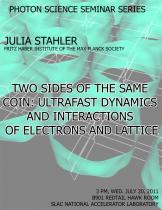Speaker: Julia Stähler, Department of Physical Chemistry, Fritz Haber Institute of the Max Planck Society
The focus of my research is the investigation of non-equilibrium dynamics at interfaces and in solids using femtosecond time-resolved pump-probe techniques.
During my PhD, I have worked on electron transfer and solvation dynamics of excess electrons in molecular adlayers on metal surfaces using time-resolved two-photon photoelectron spectroscopy. The dynamics observed in these studies result from the interaction of single electrons with their molecular surrounding and the underlying metal substrate. Another very interesting field of solid state physics is the area of strong correlation effects such as Mott transitions and unconventional superconductivity. While staying in Oxford, I worked on the antiferromagnetic insulating to superconducting phase transition in quasi 2D organic salts using time-resolved THz spectroscopy.
Program Description
The optical and electronic properties of any material are crucially determined by the interplay the electrons and the ion cores. When this equilibrium is disturbed by, for instance, absorption of photons, the system will eventually equilibrate again; however, the ultrafast non-equilibrium dynamics of the photoexcited carriers provide information on the nature of the electron-lattice interaction. Examples for such interactions are elementary phenomena as adiabatic heterogeneous electron transfer at molecule-metal and semiconductor interfaces, carrier localization through polaron formation, coherent control of lattice vibrations, and photo induced phase transitions
We use femtosecond time-resolved optical and two-photon photoelectron spectroscopy to study such ultrafast carrier and lattice dynamics in solids and at their interfaces. These are applied to two quite different systems in order to highlight a whole potpourri of dynamics and interactions of electrons and lattices: The non-equilibrium response of the strongly correlated electron material VO2 to photoexcitation helps to illustrate the interplay of ion cores, lattice potential, and electrons: With a double-pump-probe experiment that makes use of coherent control of optical phonons, we monitor the onset of the photo induced insulator-metal transition in VO2 and demonstrate an ultrafast symmetry raise of the lattice potential on sub-phonon period timescales before the ions can respond to the electronic excitation. The influence of nuclear reorientation on heterogeneous charge transfer dynamics, on the other hand, is studied at ice-metal interfaces. Here, the polar ice environment responds to the presence of an excess electron, leading to a transient degree of localization that varies the electronic coupling to the continuum of substrate states. It will be shown that, depending on ice structure and morphology, the highly efficient dipolar screening of the ice can enhance the excited electron lifetimes from femtoseconds up to minutes.





